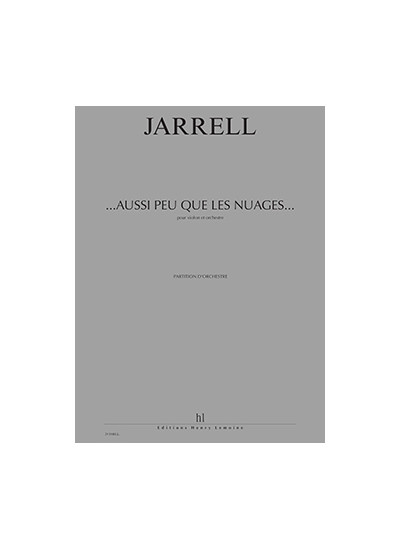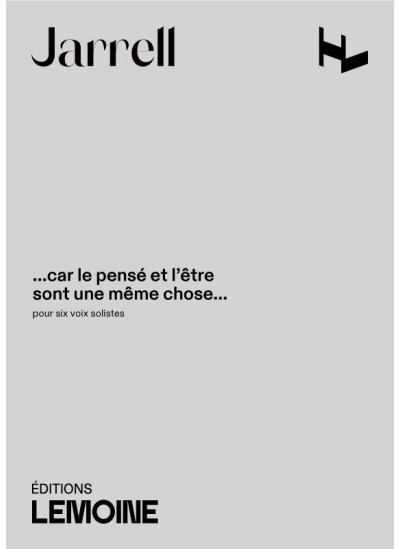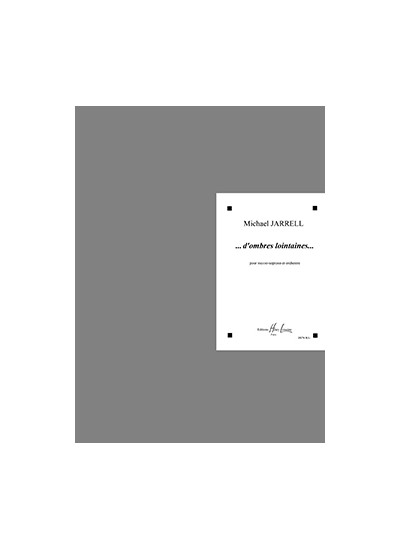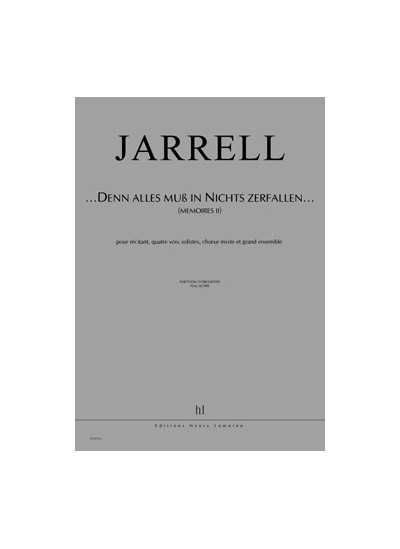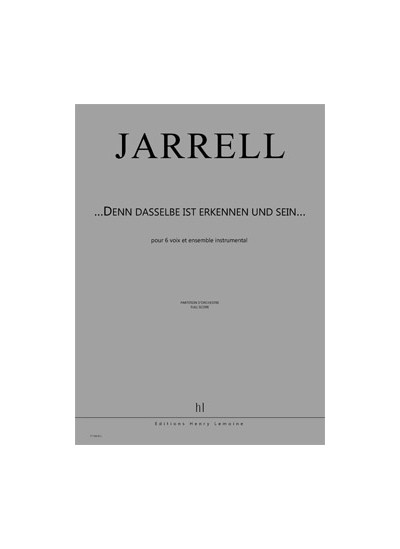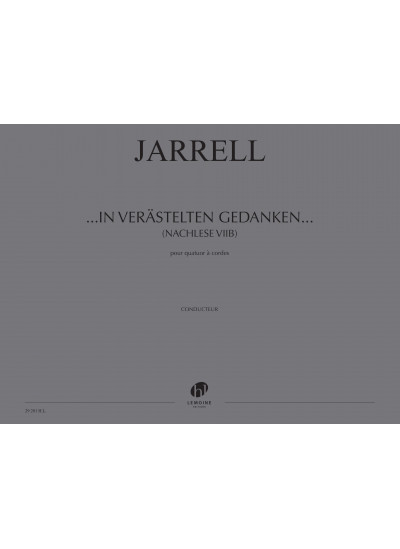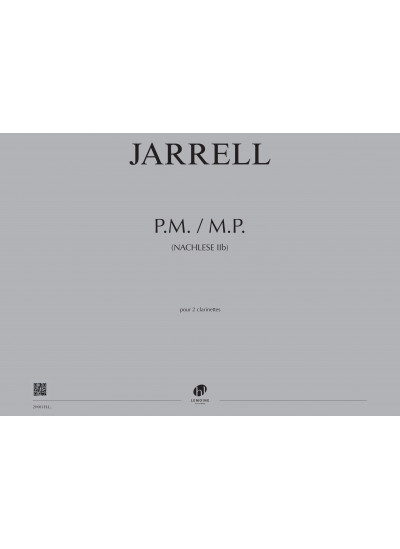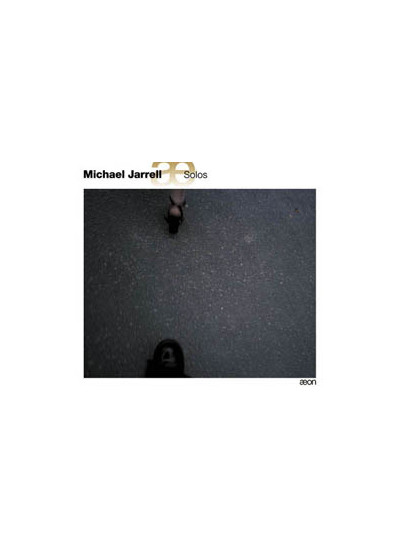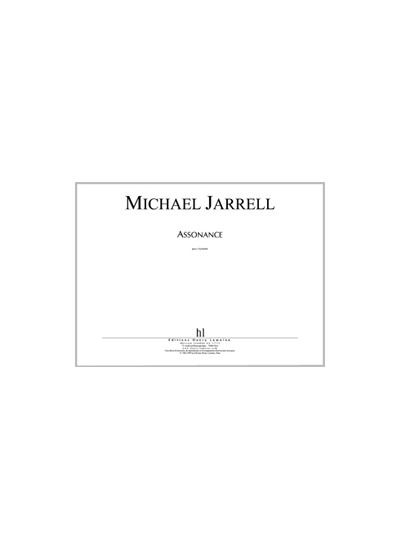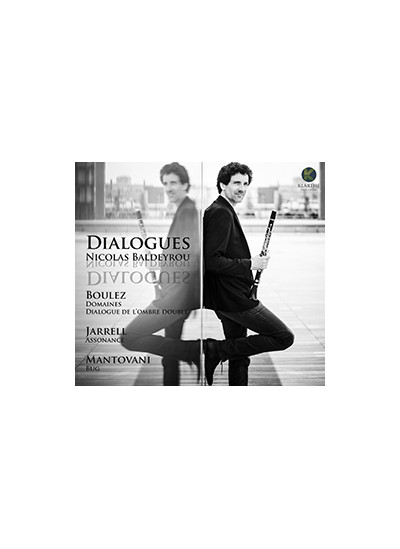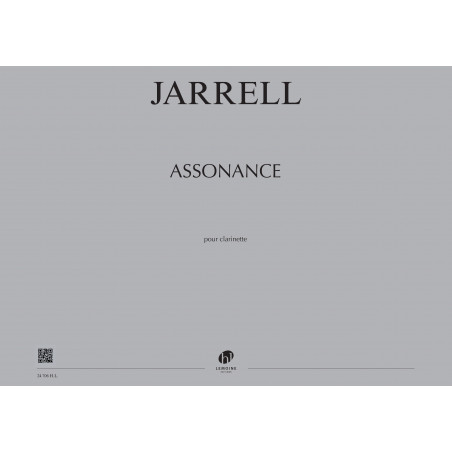
22/08/1984 - Aspen Festival, Colorado (USA) - Nicholas Cox (cl)
Michael Jarrell's series of "Assonances", like Berio's "Sequenze", is basically cyclical, although the pieces are not necessarily written for solo instrument. The composer himself considers them rather as "sketch-books", "as the right to concentrate on a single idea and to feel free to do so"*.
Assonance for solo clarinet, which was created by Nicholas Cox, on 22 August 1984 at Aspen Festival (Colorado), is the first in the series, and is a perfect illustration of the composer's ideas. The limits of the musical means are clearly felt although without impinging on the instrumental virtuosity. A few basic elements serve as a starting point, such as this first cell, that is then heard again (like the other initial elements) in different forms, such as at a slower tempo, with trills and regularly added extra notes or again in the form of a varied repeat, very shortly before the end of the work. The entire work rests on a very precise network of relationships between different musical elements that are based either on phenomena that it is difficult to perceive consciously (like the previous ones) or, on the contrary, sections that are quite distinct from each other, and that the listener easily perceives on account of their relationship of opposition, contrast or complimentarily. The varied return of the opening finally yields to a coda that is essentially founded on the polyphony dimension of the instrument, which had lain just below the surface since the beginning. The work thus presents two simultaneous paths: one is circular, and returns to the elements of the beginning alter having followed a certain trajectory - while the other resolves a musical idea (polyphony) that develops regularly and progressively. Assonance is a good illustration of its own title (an ancestral rhyming scheme), but its abundant wealth, combined with rigour and poetry, go well beyond the realms of mere procedure.
Pierre Michel,
Translation: Mary Criswick
extract from the booklet Solos (CD aeon)
* Danielle Cohen-Lévinas (translated by Mary Criswick), "Entretien avec Michael Jarrell", in Les Cahiers de L'Ircam, "Compositeur d'aujourd'hui" series, 1992, p.11.
In his work Assonance for clarinet (1983), Jarrell describes the "states" of the instrument, so that the single clarinet appears in fact to be many different clarinets, rather in the style of Berio's Sequenzas. Taking, as he often does, a serial-sounding theme as his starting point, Jarrell then turns it round like an architectural design or a painter's sketch. This idea lies at the root of all the Assonances pieces, and gives rise to situations which begin but do not end, where a vision of the sound transmitted through the virtuosity of the instrumentalist alternates with the sophisticated musical style which is closer to an exaltation of ornamentation rather than any musical grammar. Jarrell departs, however, from the Berio model of the clarinet Sequenza in which the composer experiments with all the possibilities of the instrument, by developing its virtuality, although without revealing the workings. The music thus occupies the entire space of the score, and is guided by the constraints of the design to be unfurled, so that the clarinet sounds above and beyond its recognized path. Jarrell reins in the music, and draws up rules. On the other hand he multiplies the technical difficulties, because he reasons that it is useless to offer new special effects to musicians if they are unable to play them. The perfect sound stops where the player's problems begin. To combat this Jarrell blends styles, the exact with the inexact, the decided with the undecided, and the reliable with the distinctly wobbly. The composer stresses the fact that there are, for instance, two kinds of multiphonic sounds: those in brackets with an imprecise sound, and those without brackets which should be played very precisely. The question of the "same" music and "different" music strikes a particularly resonant chord in the timbre. If a style of play, a rhythmic motif or a melodic cell can be taken both for a desired sound and its opposite, this is because the syntax which underlies this vision is both flexible and strict, intuitive yet intellectual, improvised yet notated, both harmonic and serial. Assonance for solo clarinet is an emblematic work, and summarizes the mixture of constraints and freedoms within which Jarrell's works are hewn.
Danielle Cohen-Lévinas,
Translation: Mary Criswick
"Entretien avec Michael Jarrell", in Les Cahiers de L'Ircam, "Compositeur d'aujourd'hui" series, 1992
Recording
1 CD aeon, AE0101, Solos
...some leaves II... - Offrande - Assonance - Assonance VII - Prisme
Ch. Desjardins - F. Cambreling - P. Meyer - F. Jodelet - H.-S. Kang
Die Reihe Assonances von Michael Jarrell repräsentiert wie Sequenze von Berio den Gedanken des Zyklus, obwohl die Stücke nicht unbedingt für Soloinstrumente geschrieben wurden. Der Komponist sieht sie als seine "Skizzenhefte", "als ein Recht: mich auf eine Idee zu konzentrieren und mich darin frei zu fühlen"*. Assonance (1993, überarbeitet 1998) für Klarinette - uraufgeführt am 22. August 1984 von Nicholas Cox beim Aspen Festival (Colorado) - ist das erste dieser Reihe und illustriert perfekt die vom Komponisten ausgedrückte Idee. Man empfindet die Einschränkung der musikalischen Mittel, obwohl die instrumentale Virtuosität selbst nicht wirklich limitiert ist... Michael Jarrell geht von einigen Grundelementen aus, darunter diese erste Phrase, die (ebenso wie die anderen ursprünglichen Bestandteile) in unterschiedlicher Form wiederkehrt: in langsamerem Tempo, mit Trillern und regelmäßig interpunktierten Zwischentönen, z.B. bei, oder aber in Form einer abgewandelten Reprise, kurz vor Ende des Stücks. Das gesamte Werk beruht auf einem präzise konstruierten Netz von Beziehungen zwischen verschiedenen musikalischen Elementen. Dabei geht es zum Teil um vom Bewusstsein schwer wahrnehmbare Phänomene (wie die vorangegangenen) oder im Gegenteil um voneinander genau abgegrenzte Sektionen, die der Hörer leicht wahrnimmt - sei es durch eine Gegenüberstellung, einen Kontrast oder eine Ergänzung. Die abgewandelte Wiederaufnahme des Anfangs mündet zum Schluss in einer Coda, aufbauend hauptsächlich auf der polyphonischen Dimension des Instruments, die dem Stück von Anfang an zugrunde liegt, Somit besteht das Stück aus zwei gleichzeitigen "Strömungen": eine ist eher kreisförmig und kehrt am Ende, nachdem sie eine bestimmte Bahn verfolgt hat, zu den Elementen des Anfangs zurück, und die andere setzt in einer regelmäßigen, progressiven Entwicklung einen musikalischen Einfall um - die Polyphonie. Assonance illustriert optimal die Idee seines Titels, eine Art von überliefertem Reim, doch geht die Komposition in ihrer Vielfalt, Präzision und Poesie weit über einen einfachen Prozess hinaus!
* Danielle Cohen-Lévinas: "Entretien avec Michael Jarrell" (Gespräch mit Michael Jarrell), aus Les Cahiers de l'Ircam, Reine "Compositeurs d'aujourd'hui", 1992, S. 11.
Pierre Michel
Übersetzung: Elisabeth Freund


